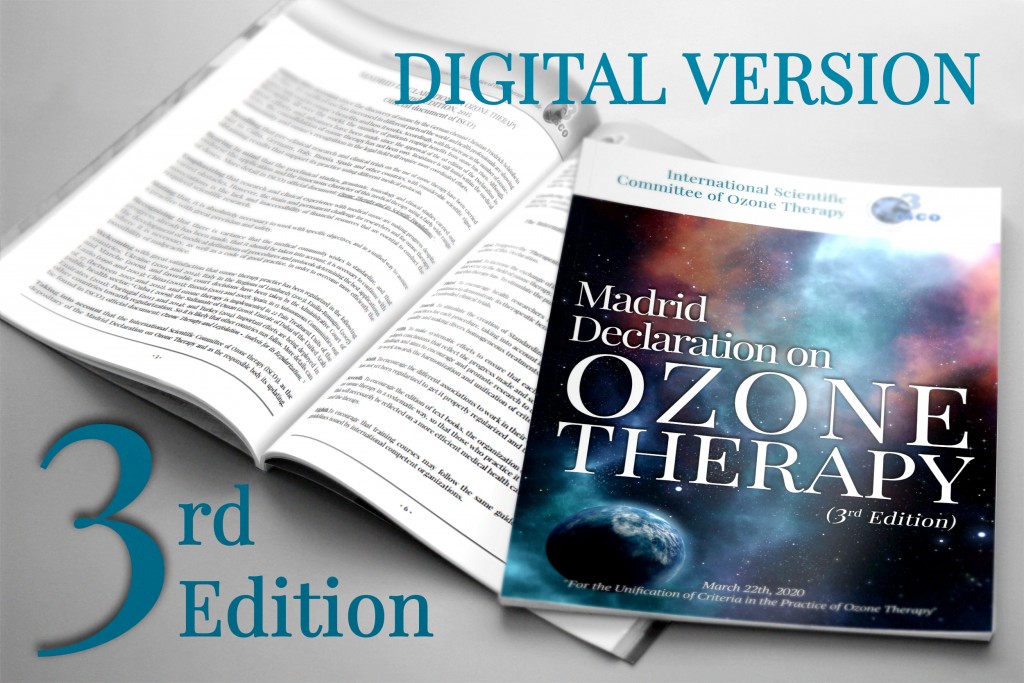Madrid Declaration on Ozone Therapy (3rd edition), 2020, 103 pages
Available in nine languages: Arab, English, French, Italian, Portuguese, Russian, Spanish, Ukrainian & Turkish.

The importance of the Madrid Declaration on Ozone Therapy
The 3rd edition summarizes the scientific research carried out in different countries and are the result of many years of experience and clinical practice.
Ozone therapists from different parts of the world participated in the update of the 3rd edition. Through this exchange and subsequent revisions, the entire ozone therapy community had an opportunity to participate in a serious medical scientific exchange with the objective of having a global document to apply to patient care and improve clinical outcomes by health care professionals.
The Madrid Declaration on Ozone Therapy serve as a source of guidance and reference tor all those who practice ozone therapy. It is up to each ozone therapist to use his or her own clinical judgment in applying the recommendations included in the 3rd edition of the Madrid Declaration on Ozone Therapy.
1st edition: June 2010 | 2nd edition: June 2015 | 3rd edition: March 2020
INDEX
Madrid Declaration on Ozone Therapy, ISCO3, 3rd ed., 2020
- THERAPEUTIC BASIS2. OZONE THERAPY (O3x) BASIC PRINCIPLES
2.1 Contraindications
2.2 Warning
2.3 Interactions with Ozone
2.4 Adverse Effects
2.4.1 Grade 1 Mild
2.4.2 Grade 2 Moderate
2.4.3 Grade 3 Severe
2.4.4 Grade 4 2.4.5 Grade 5
2.5 Toxicity
2.6 Pediatrics Dosages through Rectal Insufflation3. MAIN ROUTES OF APPLICATION
3.1 Recommended Systemic Routes of Application
3.1.1 Major Autohemotherapy (MAH)
3.1.2 Minor Autohemotherapy (MiAH)
3.1.3 Ozonized Saline Solution (O3SS)
3.1.4 Extracorporeal Blood Oxygenation-Ozonation (EBOO)
3.1.5 Rectal Insufflation
3.1.6 Vaginal Insufflation
3.2 Recommended Routes of Application with Local Effect
3.2.1 Intramuscular, Paravertebral and Intra-Articular Injection
3.2.2 Paravertebral Intramuscular Injection
3.2.3 Hernias
3.2.4 Intradiscal Treatment
3.2.5 Sacral Hiatus/Transluminal Peridural Infiltration
3.2.6 Intraforaminal Infiltration
3.2.7 Intra-articular Treatment
3.2.8 The Gloves Technique (Emphysema subcutaneous technique)
3.2.9 Gasification in Plastic Bag
3.2.10 Subcutaneous (Mesotherapy) Application
3.2.11 Ozone Suction Cup
3.2.12 Insufflation in Fistulas
3.2.13 Ophthalmologic
3.2.14 Insufflation Vesico-Urethral
3.2.15 Intra Prostatic
3.2.16 Otic Route
3.2.17 Intratonsillar Infiltration Route
3.2.18 Ozone Micro Doses in Trigger and Acupuncture Points
3.2.19 Topical Application of Water, Oil and Ozonized Creams
3.2.20 Sauna Cabin or Quasi-Total-Body Exposure to Ozone
3.3 Application Routes not Recommended for not Being Safe
3.3.1 Direct Intravenous Injection of Ozone (DIV)
3.3.2 Intra-Arterial Injection
3.4 Application Route Prohibited
3.5 Application Routes that Have not Received Total Consensus
3.5.1 Injection of Ozonized Water
3.5.2 Injection of Ozonized Glucose Solution
3.5.4 Intraperitoneal Ozone4. PATHOLOGIES MORE APPROPRIATE TO BE TREATED WITH OZONE THERAPY
4.1 Diseases in the Level A
4.2 Diseases in the Level B
4.3 Diseases in the Level C5. GENERAL BASIS FOR TREATMENT
5.1 Essential Requirements
5.2 Basic Rules to Perform Training in Ozone TherapyReferencesADDENDUM A. Applications of Ozone in DentistryADDENDUM B. Applications of Ozone in Veterinary Medicine
